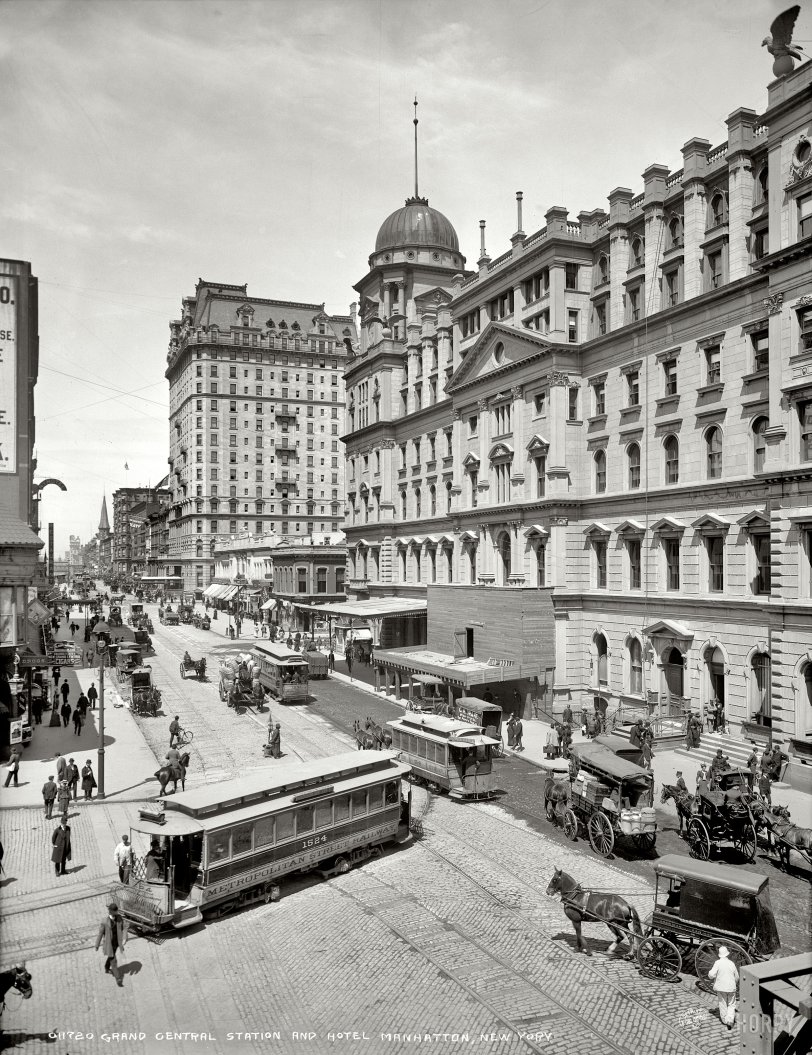


Framed or unframed, desk size to sofa size, printed by us in Arizona and Alabama since 2007. Explore now.
Shorpy is funded by you. Patreon contributors get an ad-free experience.
Learn more.

- Freeze Frame
- Texas Flyer wanted
- Just a Year Too Soon
- WWII -- Replacing men with women at the railroad crossing.
- Yes, Icing
- You kids drive me nuts!
- NOT An Easy Job
- I wonder
- Just add window boxes
- Icing Platform?
- Indiana Harbor Belt abides
- Freezing haze
- Corrections (for those who care)
- C&NW at Nelson
- Fallen Flags
- A dangerous job made worse
- Water Stop
- Passenger trains have right of way over freights?
- Coal
- Never ceases to amaze me.
- Still chuggin' (in model form)
- Great shot
- Westerly Breeze
- For the men, a trapeze
- Tickled
- Sense of loneliness ...
- 2 cents
- Charm City
- What an Outrage
- Brighton Park
Print Emporium
Grand Central: 1906

New York circa 1906. "Grand Central Station and Hotel Manhattan." The coming decade would see the replacement of this structure by the current Grand Central Terminal. Detroit Publishing Company glass negative. View full size.
Sharing the tracks
In the lower right, under the American Express horse, are the remains of the railroad tracks crossing the horse car track. They joined the trolley track on Fourth Avenue or Park Avenue South, as shown in other Shorpy photos. Even after the 1st Grand Central was built about 1873 and steam locomotives were banned from the streets of lower Manhattan, the New York, New Haven & Hartford RR still insisted on using horses to pull its passenger cars farther downtown over these tracks.
The eagles of Grand Central
A search for Grand Central Eagles yields interesting stories.
The couple who found one in their back yard.
And the story of one that ended up Upstate.
Poor Grand Central Station only lasted 12 years: from 1898 to 1910.
Broncs to Bikes
Urban horseback riders at the turn of the last century were regarded in a similar way to how we view motorcyclists today; traveling light, moving fast, a bit intimidating (ex: mounted police), a little daredevilish & somehow just a touch less civilized. I mean, you never see the very Edwardian Sherlock Holmes mount a horse except in an emergency.
In many ways, today's bikers have adopted the horseman's accoutrements and lingo: leather chaps, buckskin and fringe, saddles and saddlebags, triple-trees, trick riding, trail runs, etc.
"I'm a Cowboy, on a Steel Horse I Ride!" - Bon (yech) Jovi
Eagle on the ball
It is speculated the that eagle below the dome ended up in Essex, NJ at the Space Farms Zoo and Museum.
http://outdoors.webshots.com/photo/1113715013034126691DiLhTm
Greg
Lone Horseman
This is the first urban horse & carriage era Shorpy picture in which I recall seeing a (civilian) man on horseback, rather than drawn in a wagon or carriage (he's right above the streetcar). Maybe I wasn't paying enough attention, though!!
I wonder if he ever took his horse up to Central Park for a lively canter.
Is this the spot?
White Wing!
The man lower right in the white suit and pith helmet is a "White Wing." These were the first street cleaners in New York.
American Express
Wikipedia tells me AmEx started as an express mail and shipping operation. What do you think this wagon's delivering, and to whom?
A streetcar named electric
The last of Manhattan's cable cars were converted to electric power around 1901. The car draws its current via a "shoe" that extends down through the slot seen running between the tracks. Same system used by electric streetcars in Washington, D.C., many examples of which can be seen on these pages:
Cable car?
I'd be pretty confident saying this is a "cable car." The Metropolitan Street Railway operated cable trolleys.
http://www.cable-car-guy.com/html/ccnynj.html#msry
San Francisco wasn't the only place that had them.
[In 1898 the Metropolitan Street Railway began converting its cable traction lines to underground electric power. - Dave]
Electric Trolley
It's surprising to see electric trolleys and horse-drawn trolleys sharing the same set of tracks, but also surprising to see an electric trolley with no overhead wires -- how did it pick up the electricity?
[Through the slot between the rails. - Dave]


























On Shorpy:
Today’s Top 5